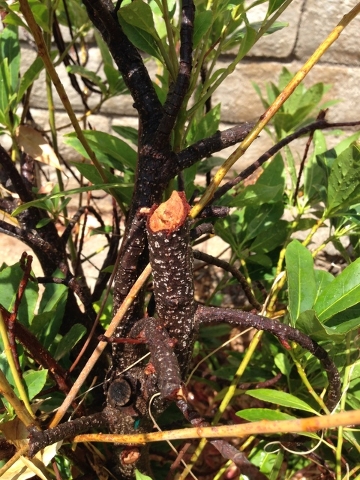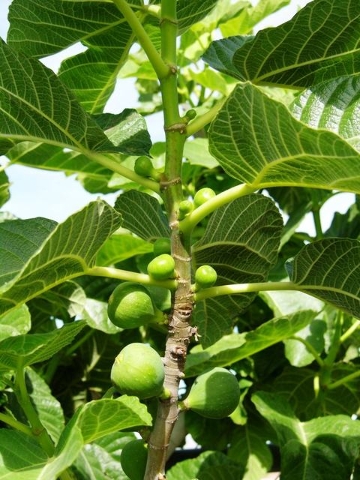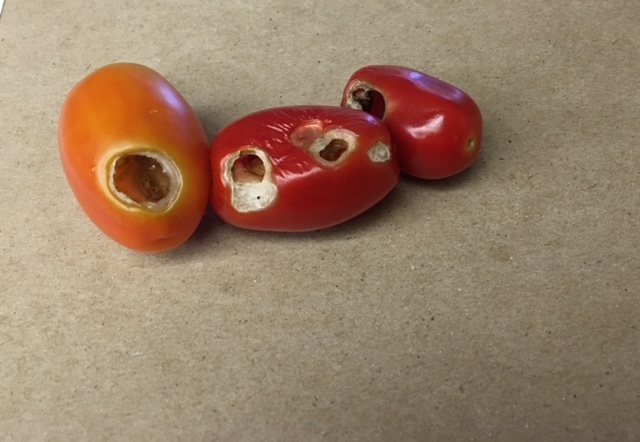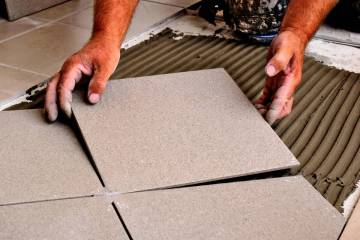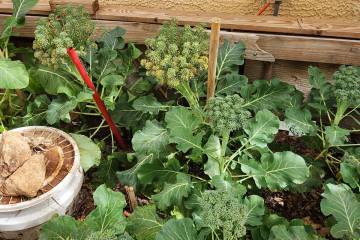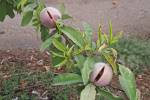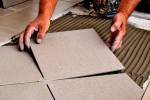Desert sun can burn plants in summer
This week, temperatures are projected to reach 117 degrees. Most landscape plants can handle these temperatures, so don’t panic.
Lawns, vegetables and annual flowers will require daily irrigations. Trees and shrubs should have at least one day of rest between irrigations.
Our light intensity is very strong in the desert. Some thin-barked trees and shrubs get sunburned if they don’t have enough protection from strong sunlight.
The natural way to protect plants from sunburn is to allow these plants to shade their own trunks and stems with leaves. Not providing enough water can thin out the canopy of trees and shrubs and encourage sunburn.
Plants that typically sunburn include many of our fruit trees, mostly peach and apples. Ornamental trees and shrubs also get sunburn. Plants that I see with sunburn include Japanese blueberry, locust trees, ash trees and Indian hawthorn.
Severe sunburn causes the plant to die on the side exposed to the sun. Bark on this side is loosely attached to the trunk.
When you pull this bark away from the trunk you may see oval-shaped holes in the wood. These are exit holes of borers. Removing the bark also removes hiding places, and birds have a better chance picking borers off when they emerge.
Having rock mulch around plants that do not like rock mulch reduces the number of leaves and increases the chance of sunburn. Plants that do not like rock mulch, like the ones I previously mentioned, will develop an open canopy, leaf loss and sunburn.
What’s the problem with sunburn? When humans get sunburn we recover. When plants get sunburn, particularly in a desert climate, they frequently decline and die.
Attack by boring insects, or borers, is the first phase after sunburn damage. The borers create more leaf loss that increases sunburn. At this point, the plant falls into a death spiral.
Use surface mulch, particularly wood chips, and not bark mulch. Don’t water trees and shrubs daily. Water them two or three times each week during the heat of the summer.
Reduce the number of times per week during the cooler months. When they receive water, it should water the roots to a depth of at least 12 and preferably 18 inches.
Q: My grapevine had grapes for the first of four years, but this and last year it had none. What is wrong with my grapevine? By all appearances, it looks perfectly healthy but it didn’t produce grapes for the last two years.
A: The fruit or berries of grapevines are produced only on the wood that grew the previous year. Growth this season and 3-year-old wood and older will not produce any fruit. Two-year-old wood is the only place that can produce flowers and fruit.
If all of the 2-year-old wood is removed or dies, there will be no flowers or fruit. If the vine is left to grow without any pruning, it will produce lots of fruit. But over the years this tangle of growth will create problems from crowding, fruit rots and disease, and it will be difficult to harvest the fruit.
Next spring, do not prune. Let the vine grow. At least this way you will get some fruit from it. Your other option is to learn how to prune grapes correctly.
Q: We have two fig trees loaded with figs. The problem is they are not ripening. What is our problem or do they take a long time to ripen?
A: Most of the main crop of figs is still green right now and has developed to maturity. If the tree is getting plenty of water, the figs should be enlarging rapidly. If the figs are not enlarging, then the tree is not getting enough water.
Figs that produce fruit need a lot of water so that the fruit will enlarge. If you don’t give the tree enough water the fruit will stay small and fall from the tree, hard as rocks.
Q: I found about four to five tomatoes with holes in them. I have been getting ripe tomatoes for about 30 days and found these with holes in them during the last two days. I searched for bugs, eggs and leaf damage but did not find anything. Any ideas?
A: The 3/8-inch diameter and larger holes in your tomatoes look like damage from the tomato fruit worm. These worms, or caterpillars, are about an inch and a half long and 3/8 of an inch wide. They eat holes mostly in tomato fruit, usually when they are green or when they turn red but are still hard or firm. Frequently the fruit becomes rotten from these holes.
Organic sprays of Bt or Spinosad when the fruits are starting to form will prevent this.
Q: I have powdery mildew on lower branches on my shrubs. Should I remove the dying leaves? Since the temperature will be 114 tomorrow, should I wait until fall?
A: Powdery mildew on these plants is probably left over from this wet spring. Powdery mildew disease does not require high humidity. As far as diseases go, it probably has the lowest requirement for humidity or moisture.
The usual reasons for powdery mildew besides cloudy, rainy weather is shade, poor air circulation and poor plant health. If you can reduce the shade with some light pruning that may help.
Make sure there is no splashing water from an irrigation system. This will spread the disease from leaf to leaf or plant to plant.
Sulfur dusts as well as neem oil have been known to work as preventive sprays. Otherwise use traditional fungicides that list powdery mildew control on the label. But with these high temperatures the disease should subside. It is a cool temperature disease.
If the leaves look pretty bad, then go ahead and remove them. At least then you are removing disease inoculum. But consider some light pruning instead. You won’t hurt anything with light pruning this time of year and you may give the lower parts of the canopy more sunlight.
Q: We have a concern about our saguaro planted in 1988. It now has three large arms and we recently noticed a crack on the outside of one arm at the bend of the “elbow.”
A: Don’t water it too often. Watering about 10 or 15 gallons around the base of the plant once a month is enough. Those plants expand like an accordion when they swell up with water.
Let them use this water before you give them another drink. The plants will shrink in size when they use their internal water supply. If they are given water too often they can swell up and split.
The splitting may have happened during the rains this spring and early summer. Regardless, the crack should heal and give the plant a little bit of character.
Q: I am concerned about one of my three bougainvillea plants growing on the south side. I removed some very old and scraggly oleanders from this spot and raked out all the oleander leaves before planting the bougainvillea. I feed them and they have good water supply, but the one in the center is scrappy looking while its brothers on either side are thriving.
A: Bougainvillea do very well here during our summer heat with a minimal amount of care as long as the soil is amended at the time of planting and they are fed regularly with low nitrogen fertilizers.
They like to be pruned so if you see them struggling, prune them back, give them water and fertilize them lightly with a rose or tomato fertilizer.
They also bloom better if they are struggling rather than if they are pampered too much. Going through a dry period may encourage blooming.
Bob Morris is a horticulture expert living in Las Vegas and professor emeritus for the University of Nevada. Visit his blog at xtremehorticulture.blogspot.com. Send questions to Extremehort@aol.com.



